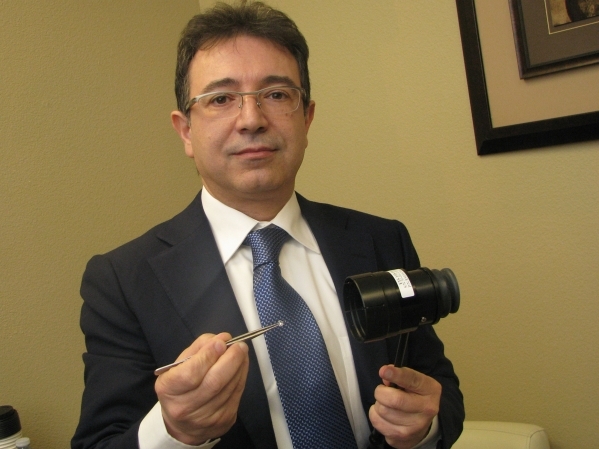Macular degeneration repaired by mini-telescope
Macular degeneration can deprive its victims of their central vision and render them blind. A new procedure coming to the Las Vegas Valley can literally bring eyesight to the blind.
’It’s a mini-telescope, like you’d see in a pirate movie, but miniaturized so that it can fit in the eye,’ said Dr. David Yesnick, optometrist and co-owner of YESnick Vision Center, 10198 W. Flamingo Road. ’It’s really life-changing technology. It’s fully FDA-approved and has Medicare authorization. The procedure is covered under Medicare insurance."
The medical condition is a common cause of blindness in seniors. The damage is concentrated in the center of the eye, and peripheral vision remains relatively intact despite the condition worsening to the point where nothing can be seen directly before a patient’s eyes. The device, created by California-based company VisionCare, is implanted inside the eye, in a similar manner to lens replacement in cataract surgery.
’The surgery takes about a half an hour,’ said Dr. Jack Abrams with the Abrams Eye Institute, 6450 Medical Center St., Suite 100. ’It can be done with sedation and a local anesthetic. It’s a same-day procedure.’
The patient is sedated, still technically awake but not aware. An incision is made in the eye, and the device is permanently implanted inside the eyeball. Modern cataracts lens replacement surgery no longer require stitches, in general, but because the device is larger, similar in diameter to a pencil eraser and nearly as tall as it is wide, the mini-telescope surgery does require a couple of stitches.
The procedure has not been performed in Las Vegas yet, but several patients are undergoing preliminary work leading toward the procedure. All of the patients who will initially partake in the procedure must go through YESnick Vision Center, which Yesnick owns and operates with his wife, low-vision therapist Sandy Yesnick, who is also an occupational therapist, a health specialist who helps people achieve independence and functionality.
"VisionCare reached out to Sandy and I earlier this year to bring this technology to Nevada,’ David Yesnick said. ’We were asked to create a team of doctors who will bring this technology to patients.’
Doctors set to perform the procedure include Timothy H. Tweito and Russell Jayne of The Retina Center, with locations at 6980 Smoke Ranch Road, 3006 S. Maryland Parkway and 870 Seven Hills Drive; Paul Casey of NVISION Eye Centers’ Nevada Eye Care, with locations at 2090 E. Flamingo Road and 7730 W. Cheyenne Ave.; Kent Wellish of Wellish Vision Institute, 2110 E. Flamingo Road; and Peter DeBry of Nevada Eye Surgery, 2390 W. Horizon Ridge Parkway.
The procedure isn’t for everyone, and there is a lengthy screening process. First, a patient is seen by a low-vision optometrist who determines the extent of vision loss and how much remains. Then, he is referred to a retina specialist who confirms that the eye is healthy enough to support the implant. After that, the patient will work with an occupational therapist, who will use a simulator —an external telescope — that will work like the implant.
’The device brings the light of the image the eye is seeing to the peripheral edge, where the eye isn’t damaged,’ Abrams said. ’With the help of the staff, patients are trained to see again.’
After weeks of training the eye to see with the simulator, the patient goes to a corneal specialist to undergo the implantation. The Yesnicks have four, including Abrams, lined up for the procedure. Finally, after the surgery, the patient returns to the occupational therapist.
’It can take three to four months of training to regain the vision the telescope is going to allow them to have,’ Sandy Yesnick said. ’It isn’t instant gratification, like a simple cataracts surgery. Also, the patient will have to adjust to monocular vision.’
The implant goes in only one eye, so patients will be able to see but without depth perception.
’Little things you or I take for granted, those are the things patients who have this procedure will regain,’ David Yesnick said. ’Putting toothpaste on a toothbrush, seeing the food on their plate or being able to see to walk safely. They’ll be able to watch television, play cards and see a loved one’s face. They will get their independence back.’
Visit theyvc.com or call 702-966-2020.
— To reach East Valley View reporter F. Andrew Taylor, email ataylor@viewnews.com or call 702-380-4532.


















